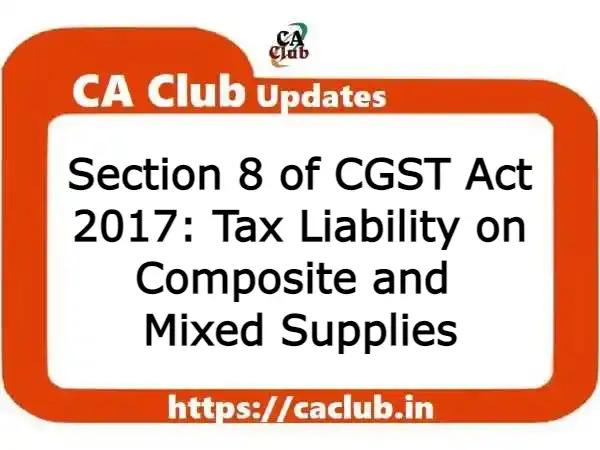Provisions under Section 8 of the Central Goods and Services Tax (CGST) Act, 2017 relating to “Tax Liability on Composite and Mixed Supplies”:
Section 8 of CGST Act 2017: Tax Liability on Composite and Mixed Supplies (CHAPTER III LEVY AND COLLECTION OF TAX)
The tax liability on a composite or a mixed supply shall be determined in the following manner, namely:-
(a) a composite supply comprising two or more supplies, one of which is a principal supply, shall be treated as a supply of such principal supply; and
(b) a mixed supply comprising two or more supplies shall be treated as a supply of that particular supply which attracts the highest rate of tax.
| Note: CBEC notifies 01/07/2017 as the commencement date vide Notification 9/2017. |
Amendments History:
NA
—-
| CGST Act 2017: Last updated 15/02/2024 |
| The CGST Act 2017 has been notified vide GOI Notification dated 12/04/2017, which has subsequently been amended through the CGST (Extension to J&K) Act 2017, Finance Act 2018, CGST Amendment Act 2018, Finance Act 2019, Finance Act 2020, Taxation and Other Laws (Relaxation of Certain Provisions) Ordinance/Act 2020, Finance Act 2021, Finance Act 2022, Finance Act 2023, CGST Amendment Act 2023, CGST Second Amendment Act 2023 & Finance Act, 2024 including various Notifications/Orders issued by the Govt./ CBIC from time to time, relating to the commencement dates of various sections and provisions in the respective CGST/Amendment Acts, wherever required. Information on this page is a section-wise compilation of the amendments to the CGST Act, 2017 made through various notifications issued by CBIC from time to time (upto 15th February, 2024), with the best possible efforts for accuracy. In any case, E&OE. For official or updated information, please visit the CBIC website. |
| Latest Updates from CBIC |
| For index of GST Circulars, Notifications, Press Releases, Orders, etc. issued by CBIC from 2017 and onwards along with Section-wise/Rule-wise Text of GST Acts/Rules: GST Updates |
